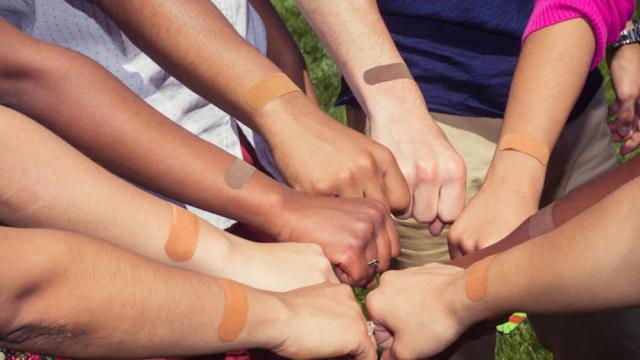Last week, Dominique Apollon, a vice president of research at Race Forward, tweeted photos of a bandage on his hand — images that went viral for shedding light on issues of inclusion for people of colour.
“It’s taken me 45 trips around the sun, but for the first time in my life I know what it feels like to have a ‘band-aid’ in my own skin tone,” he wrote in the original tweet. “You can barely even spot it in the first image. For real I’m holding back tears.”
It’s taken me 45 trips around the sun, but for the first time in my life I know what it feels like to have a “band-aid” in my own skin tone. You can barely even spot it in the first image. For real I’m holding back tears. pic.twitter.com/GZR7hRBkJf
— Dominique Apollon (@ApollonTweets) April 19, 2019
Since 1920, band-aids have been manufactured in the familiar “flesh-coloured” soft pink. And while seemingly inconsequential, a band-aid that blends into different skin tones is important and should accurately reflect a spectrum of tones across our population — I often have trouble finding a band-aid that doesn’t look so glaringly obvious against my skin. Star Wars’ John Boyega even chimed in on the pink band-aid debate on Twitter, saying make-up artists often have to paint the bandages brown just so that some actors can film with them on.
“… I want you to know that for me it is not about merely providing a perfectly matched bandage for every colour,” Apollon wrote in a follow-up tweet. “It’s providing the broader emotion/sense of #belonging it happened to give me, to ALL people.”
[referenced url=”https://www.lifehacker.com.au/2018/06/how-to-turn-a-regular-bandage-into-a-fingertip-bandage/” thumb=”https://i.kinja-img.com/gawker-media/image/upload/t_ku-large/bggt3tdt35ngvuauvhey.gif” title=”How To Turn A Regular Bandage Into A Fingertip Bandage” excerpt=”If you have a cut on the tip of your finger, don’t despair when your bathroom first aid box only contains regular, straight plasters instead of those specialised fingertip bandages. You can make one with just two snips of your scissors.”]
How can you find a band-aid that’ll fit your skin tone? Apollon used Tru-Colour Bandages which offers three different skin tone shades based on the Fitzpatrick scale (that categorizes different complexions according to their tolerance to sunlight): olive, brown, and dark brown. While the company is based in the US, it happily ships its products to Australian customers.
Toby Meisenheimer, Tru-Colour Bandage’s founder, originally created the company after seeing the lack of options for his adopted son, who is black.
“If you live with the privilege of always having your skin-tone shade represented, you may not truly realise how revolutionary it can be to find inclusive bandages, so it’s an opportunity to see the world from another’s perspective,” he said in an email. “In the end, it’s about having a choice that didn’t exist before.”
Alternatively, clear Band-Aid strips will also minimise the colour clash.

Comments